The text below was copied from the 36th Armored Infantry Regiment, 3rd Armored Division Historical and Pictorial Review ("yearbook") dated 1942. It is listed as Published and Copyrighted 1941 by The Army and Navy Publishing Company, Inc. Of special interest is the last paragraph which states that the divisional patch is to be worn on the left breast of the field jacket! It is doubtful that this practice continued after the division left the U.S. "Description: The colorful triangular shoulder patch worn on the left shoulder ofsoldiers and officers of the 3rd Armored Division has a history, one that is varied and dates back to the old tank battalions of World War days. To it have been added additional symbols. Forming the basic pattern of the insignia are three equal segments of yellow, red and blue. The yellow, on top, represents the cavalry, the blue in the lower left hand part of the triangle represents the infantry, and the red in the lower right the artillery. Superimposed on the three equal sized torques is the insignia of the Seventh Cavalry Brigade (Mechanized), one of the first mechanized units of the new Army. The combination of the insignia of the old tank battalions and the cavalry brigade is symbolic merging of those arms as the progenitors, or parent organizations of the Armored Force. The Seventh Cavalry Brigade's insignia is a tank track, representing mobility and armored protection, a cannon running diagonally across the tank track, representing fire power, and a red bolt of lightning, representing shock action. The cannon and tank track, outlined n black, represent a general's command - in this case the command of Major General Walton H. Walker. The "3" at the top represents the Third Armored Division. The patch, in addition to being worn on the left shoulder of the blouse, or coat, is worn on the left breast of the field jacket." |
3rd Armored Division Insignia |

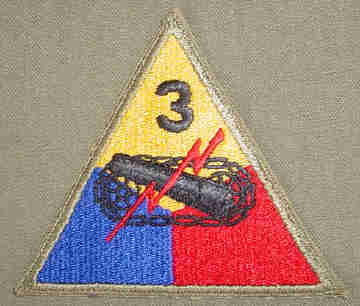
World War II 3rd Armored Division Patch The patch is embroidered on cotton and measures approximately 3 and 3/4 inches on each side. Note that the embroidered border is OD green in color and is the same thickness as the rest of the patch. These patches are commonly referred to as "flat edge" or "cut edge" patches because of their constructon. The "Spearhead" tab was not worn until very late in World War II, and probably not until after VE Day. |
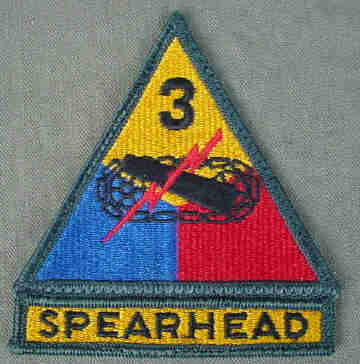
Post-1956 3rd Armored Division Patch In 1956, the army went to the darker, "Army Green" (AG) dress uniform, and the former OD green borders of patches were changed to match the new uniform. The "Spearhead" tab was made an official part of the patch immediately after WWII. Although these patches still featured the "flat edge," the color of the border shows it to be a post-1956 patch. This patch, even without the "Spearhead" tab is not authentic for wear with WWII uniforms, and should not be worn with them. |
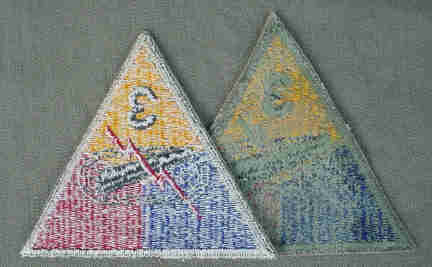
WWII 3rd Armored Division Patches - Back Shown here are the backs of two typical 3rd Armored Division patches. Note the white threads on the left patch and the green threads on the right patch. This is typical of WWII-era patches, and is referred to as "snow" by collectors. Rightly or wrongly, the "greenback" patches are generally considered to be more collectible. |
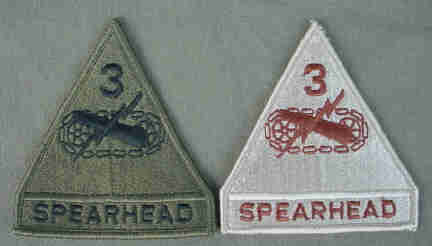
Subdued 3rd Armored Division Patches Left-Black on green subdued 3AD patch for wear on the fatigue uniform or BDUs. This patch came out in the late 1960s. Right-Brown on tan subdued 3AD patch for wear on the desert combat uniform. This patch came out in the late 1990s. Neither patch should be worn on a WWII uniform. |
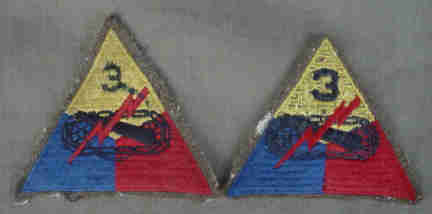
Embroidered on OD Wool Patches These patches are embroidered cotton thread on OD wool backing. The patch on the left is a plain armored force patch that has had the numeral 3 applied, clumsily, in black ink. The right hand patch has an embroidered numeral 3. They are pre- or early-WWII patches, but similar versions were made after the war. |
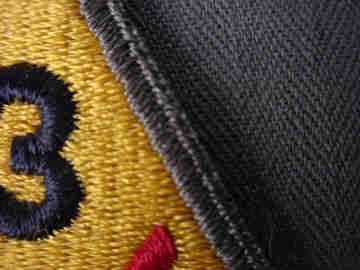
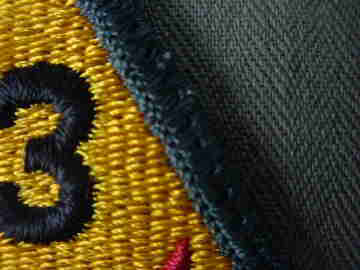
Flat Edge vs. Merrowed Edge As mentioned above, the typical WWII patch is made with a so-called flat edge as shown in the top photo. The edge is a brownish OD green, and is the same thickness as the rest of the patch. The merrowed edge patch is typical of post - 1966 construction and although hard to tell from these photos, the difference is readily apparent. Merrowed edges have a distincive "looped" appearance, and are noticeably thicker than the rest of the patch on the front side. On the back of the patch, a chain-stitch "tail" is found which is the method used to finish the binding of the merrowed edge. This tail is often held in place with a small piece of tape or a dab of glue. The tail is also sometimes trimmed completely off. Merrowed edges are never found on World War II 3rd Armored Division patches. |